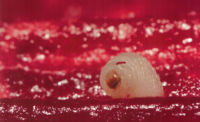It’s been 100 years since American Licorice Co. first began doing business in a rented space on W. Jackson Blvd. in Chicago in 1914.
The company’s first candy was Black Licorice Twists, and at the time, they weren’t a treat for children.
“During the depression, black licorice cigarettes and licorice cigars were made,” reads a company history on the American Licorice website.

|
| The American Licorice factory in Chicago. Photo provided. |
Now, a century later, the company has a full portfolio of delicious licorice products and chewy candy treats that are great for everyone in the family. And, in celebration of their 100-year anniversary, they’re refreshing their flagship brand: Red Vines.
“The iconic licorice that has captured hearts for generations is updating its look to bring happiness to candy lovers and begin the next chapter in American Licorice Co.’s storied 100-year history,” says Susan Shimotsu, a spokeswoman for the confectionery manufacturer.
The new packaging will feature a more vibrant red, white and blue look, that’s more modern, bolder and more playful. The package also will feature more playful and fun curvy typography and whimsical patterns.
And, in keeping with company’s vow of being socially responsible, the package will also feature front-of-pack calorie information that adheres to the National Confectioners Association’s Treat Right guidelines.
Indeed, Red Vines have come a long way since it first launched in the 1950s. That’s when American Licorice Co. expanded beyond traditional black licorice and began producing Raspberry Vines, which would eventually be renamed Red Vines.
“Unlike black licorice, which uses extract from the Glycyrrihiza glabra bush root for its flavoring, red licorice has a fruitier taste. The public called it red licorice because of its similarities in format and texture to the original black,” reads the company history.
And, although sales were slow for red candy at first, eventually, they outpaced the black licorice.
As for American Licorice’s move to the West Coast, that started in 1925 when the company purchased the assets of a bankrupt licorice company in San Francisco named Universal Licorice Co. and began operations there.
Although it was a difficult time to start up a new operation, the company persevered, shipping virtually all the candy made each day to customers.
“That year Charlie Chaplin asked the company to create a licorice shoe to be used as a prop for his classic film The Gold Rush, in which his character eats shoe leather to avoid starvation,” the company says.
In 1969, a project to move San Francisco operations to Union City, Calif. broke ground, with candy production beginning in 1970.
Four years later, the Chicago plant was relocated to a 40,000-sq.-ft. space in nearby Alsip, Ill.
“That decade Purple Vines (grape flavored), Green Vines (peppermint flavored), and Chocolate Vines were created,” the company says. “At one point a Natural Licorice Bar, sweetened with only molasses, was made. A Natural Orange Bar was also made with natural flavor and colored with annatto seed powder. This natural coloring agent was used by the Central American Indians as facial war paint.”
Eventually, corporate headquarters moved to Oregon in 2000.
And, for those wondering when the company puckered up, it was 1990 when American Licorice expanded into the sour candy market with the Sour Punch brand, sour-flavored candy in a thin straw format. Later, various other sour brands were created over the next decade: Sour Punch Bits, Sour Punch Ropes, Sour Punch Beanz and Sour Punch Twists.
And as the brand enters the next century in its sweet journey, there’s little doubt they’ll continue to create delicious treats that delight fans for the next 100 years.





